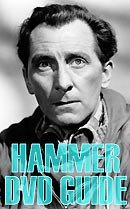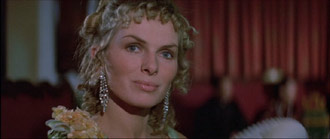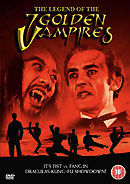
|
THE LEGEND
OF THE SEVEN GOLDEN VAMPIRES
Director: Roy Ward Baker
Starring: Peter Cushing,
Julie Ege, John Forbes-Robinson
Dracula
travels to China to assist a local vampires in the hunt for a lost member
of their group, but faces the combined forces of the local villagers and
an old foe. THE FILM
A
strong candidate for Hammerís strangest film,
The Legend of the Seven
Golden Vampires can, in retrospect, be seen as a desperate cash-in on
the tail end of kung-fu craze of the mid-70s. The film, produced by Hammer
and chop-socky exploitation masters Shaw Brothers, borrows its key plot
elements from The Seven Samurai (Shichinin no Samurai, 1954)
(or, more likely, given that Hammerís influences are more likely to have
been low-brow than art-house, its unacknowledged 1960 remake, The
Magnificent Seven). THE REGION 0 ANCHOR BAY DVD The film was heavily re-edited for its American premiere, and was eventually released in a 75 minute version as The 7 Brothers Meet Dracula. Both the original UK and American versions of the film are presented on the Anchor Bay disc. The American reworking is a mess, but film students and fans may gain some entertainment value in comparing the two versions. The 7 Brothers Meet Dracula is a welcome bonus, but largely disposable. Both versions of the film are presented in widescreen format. For the purposes of this review, we'll be comparing the Anchor Bay and Warner Home Video versions of The Legend of the 7 Golden Vampires. Anchor Bayís version is in the filmís original widescreen ratio (2.35:1), although not enhanced for 16:9 TVs. Close examination shows that the Anchor Bay version is slightly cropped at the sides, and compensates for this by being stretched horizontally, in comparison to the Warner Home Video version, (as can be seen from the screen grabs, below). The Anchor Bay version has an average bit rate of 5.12Mb/s, and this fluctuates widely between about 2.1Mb/s and 8.9Mb/s. The English audio track (the only one offered) is in mono 2.0 format at 256kbps. There are no subtitles. The Anchor Bay disc also contains the complete original soundtrack album, which retells the story with sound effects and music from the film, and features especially-recorded narration by Peter Cushing. Itís no substitute for owning a copy of the LP (with itís very nice sleeve), but is a very thoughtful addition to an already very worthwhile release. The only other extra is a smeary 1.85:1 trailer for the American version. THE REGION 2, 4 and 5 WARNER HOME VIDEO DVD Before Warner Home Video's DVD version, The Legend of the 7 Golden Vampires had never been given an acceptable video release in the UK. The VHS versions were in pan-and-scan format, and were cut by twelve seconds by the BBFC to remove some of the nunchaku action. Thankfully the UK DVD presentation is apparently uncut: according to the BBFC the old version was 85'11", and the new version is 85'32". The Warner Home Video version offers mono audio at 192kbps, and a host of subtitle options, including English and English HoH versions. The disc also has French and German mono audio tracks. The average bit rate for the Warner version is 5.91Mb/s, rarely peaking above 7.5Mb/s, but very rarely dipping below 5.3Mb/s. The UK disc features the theatrical version of the film, and nothing else: if you want The 7 Brothers Meet Dracula and the soundtrack album you'll have to get the Anchor Bay disc. Menu screens from this disc can be seen here. COMPARING THE TWO DISCS Given that Warner Home Video is a major studio, and has the benefit of six years of advances in technology and transfer techniques, it's not surprising that the 2004 UK transfer improves on Anchor Bay's 1998 transfer in just about every respect. Warner's disc offers an image which is generally more naturalistic. Colour balance, shadow detail and contrast are all improved. However, there are some curious anomalies between the two transfers, which can be seen from the second and fourth pairs of images, below. Note that, in the second pair of images, the green lighting in the temple is almost entirely absent from the Anchor Bay version. The Anchor Bay version seems punchier, and brighter, which may have had the effect of bleaching some of the colours. The Anchor Bay version looks much sharper, but this is an illusion: it has a lot of artificial edge-enhancement, which can be seen in the uncompressed enlargements of the final pair of screen images. Note the edge halos on the Anchor Bay version, and the resultant compression artefacts. The enlargements also more clearly show the black crushing present in the Anchor Bay version, in the shadowy areas below the man's torso. The Warner version offers a smoother image, but one that lacks the "snap" that some viewers may prefer. The film looks to be in pretty good shape. Both transfers demonstrate wear and tear, although the Anchor Bay version looks rougher. It seems likely that Warner's source is closer to the original camera negative. Artefacts from one version aren't always present on the other. Warner's transfer is more detailed, so inevitably the film's inherent flaws can be seen more clearly. The fourth pair of screen grabs, showing Kah's encounter with Dracula, demonstrate the one aspect where Anchor Bay's transfer definitely scores over the Warner Home Video version. The Warner subtitles are in a poorly-chosen font that makes them unusually difficult to read. Comparisons between the English audio tracks on the two discs reveal that the Warner version offers better fidelity (the Anchor Bay disc sounds slightly muffled), but at the expense of more hiss and other minor impairments. Neither version is particularly satisfying, but both are acceptable. SUMMARY Hammer fans will want to own both discs: the Warner Home Video version for the improved anamorphic transfer, and the Anchor Bay version for the supplements. |
|
Left: Warner Home Video's new Region 2, 4 and 5 version Right: Anchor Bay's Region 0 NTSC version |
||
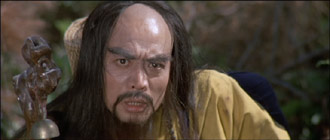 |
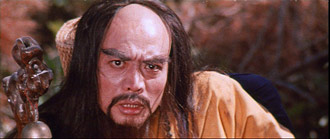 |
|
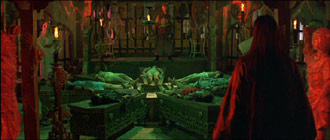 |
 |
|
|
|
 |
|
 |
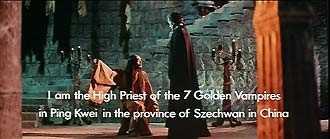 |
|
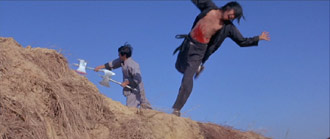 |
 |
|
 |
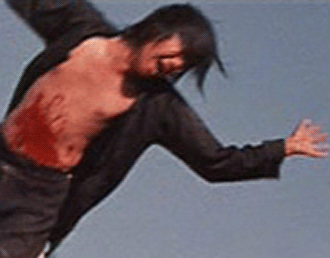 |
|



